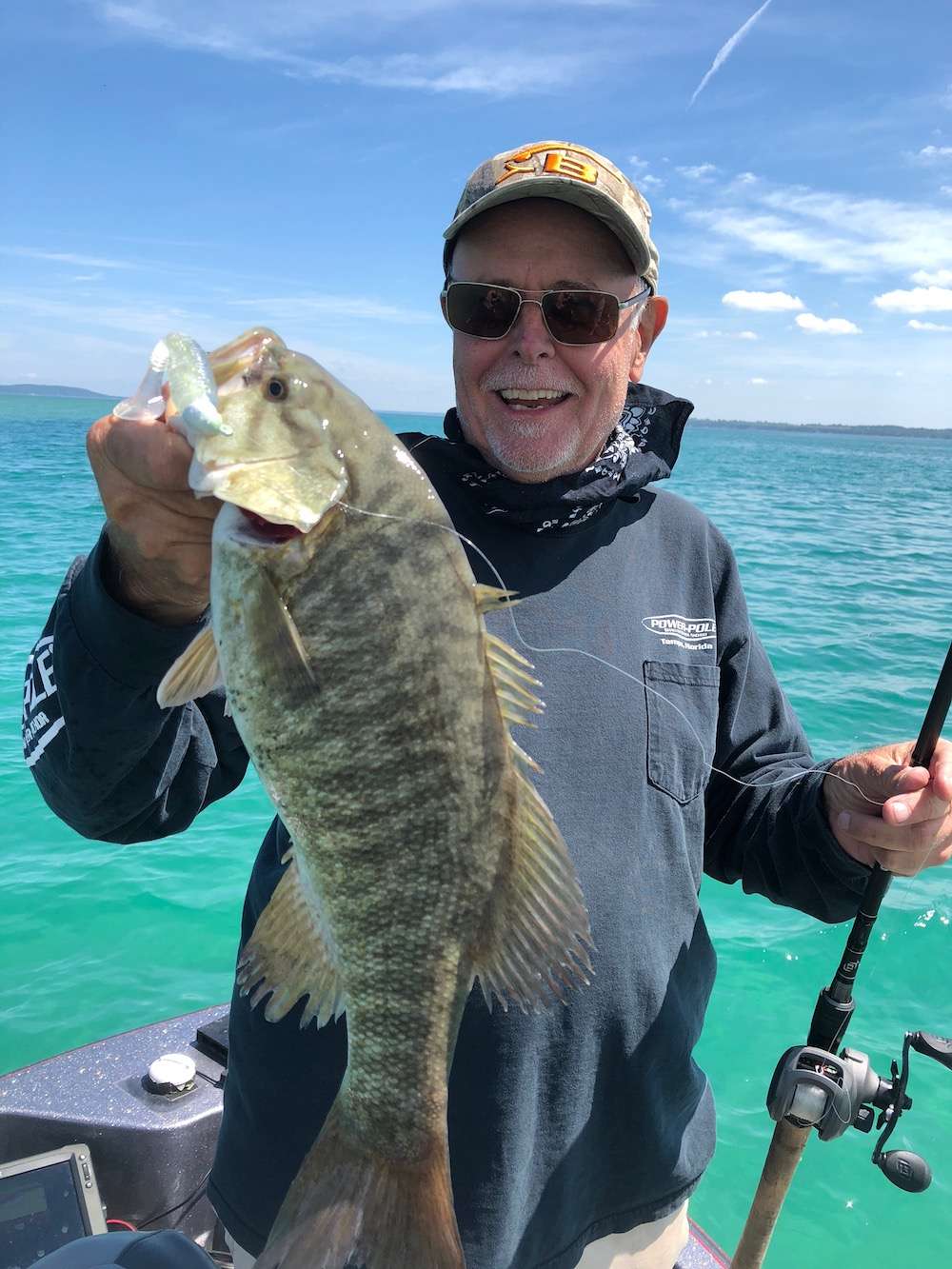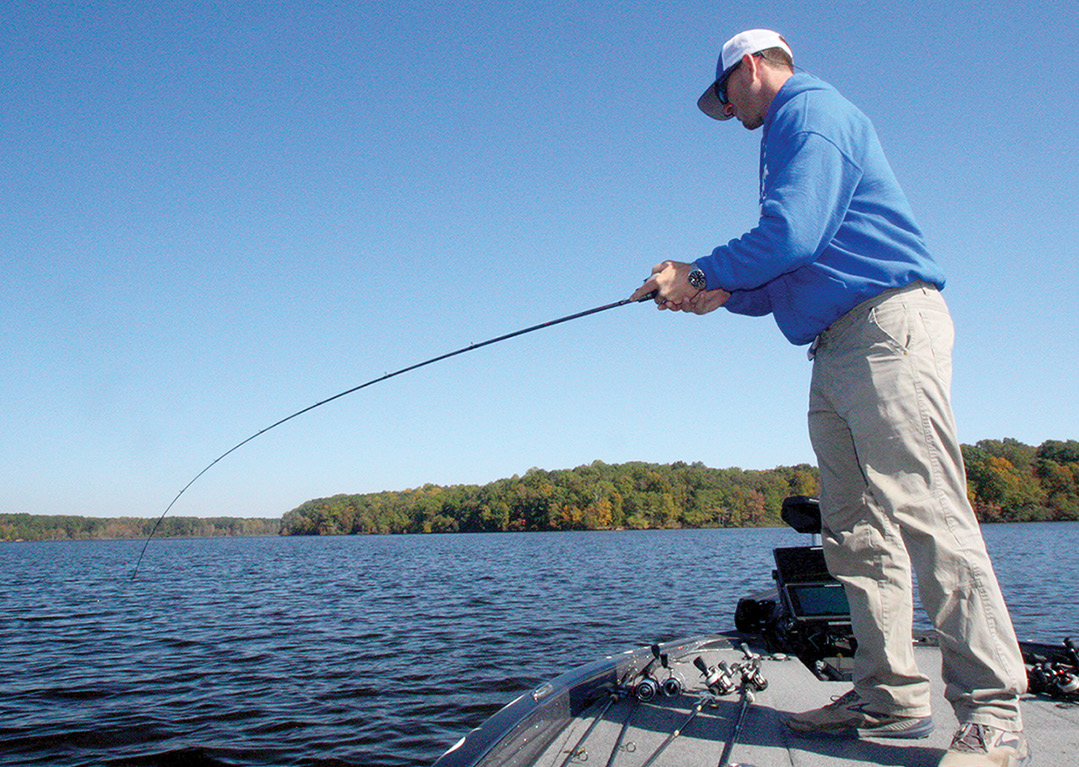
DOTL Challenge: Put a Bassmaster Elite Series pro on a small lake he’s never seen before. Give him seven hours to locate and catch bass while we log his every move.
Date: Nov. 1, 2023 Venue: Lake L, a flatland reservoir
Water: 65 to 74 degrees, stained to muddy
Weather: Partly cloudy, windy, high of 74 degrees
Pro: Marc Frazier, 30, Newnan, Ga. Frazier qualified for the 2021 Elite Series via the St. Croix Bassmaster Opens presented by SEVIIN. He’s competed in two Bassmaster Classics.
Boat: Phoenix 920 Elite with 250-horsepower Mercury outboard, MotorGuide trolling motor, Lowrance electronics, and twin Power-Pole shallow-water anchors

Marc Frazier’s boyhood dream was becoming a major league ball player. The kid was a natural. He started playing baseball at age 4; by the time he was a teen, he was not only a standout pitcher, he also excelled at first and third bases. Frazier was so talented, the San Francisco Giants drafted him straight out of high school! But Frazier turned down the offer and accepted a baseball scholarship at Chipola College (Florida) instead. “I wanted to play college ball to enhance my position in the draft,” he explained. “Then I injured my pitching elbow and had to undergo Tommy John surgery.” Upon healing, Frazier transferred to Nicholls State University in Louisiana. “Nicholls State is in the heart of redfishing and duck hunting country. My dad had gifted me a johnboat, and when I wasn’t playing ball or studying, I was on the water fishing or hunting. Growing up, I’d enjoyed fishing but wasn’t nearly as serious about it as my older brother Micah. His dream was becoming a bass pro, and he became an Elite Series competitor in 2015.” But as Frazier spent more time on the water, his interest in fishing intensified. “I gradually found myself wanting to learn more about it and get better at it.” His career goals took a sharp turn when he graduated and transferred to Auburn University (Alabama). “My initial plan was to pursue a master’s degree in adult education while finishing my final year of baseball eligibility. But I’d towed my boat to Auburn and started fishing nearby Lake Martin for bass every chance I could, and before long I was totally eaten up by the bass bug.” Long story short: Frazier was not drafted into the major leagues. Instead, after college he focused on becoming an Elite Series pro by competing successfully in both the Alabama Team Trail and St. Croix Bassmaster Opens presented by SEVIIN. How did the ace-pitcher-turned-master-caster fare on his DOTL? If you’ve ever struck out on a late fall bass outing, what follows should prove helpful.
• 6:52 a.m. It’s pitch dark, calm and 56 degrees when we arrive at Lake L’s boat launch. Frazier pulls an assortment of Abu Garcia rods and reels from storage; many are rigged with Spro hard baits and Nories soft plastics. The rising sun reveals baitfish flipping on the surface. “That’s a good sign! I’ll start off shallow with a topwater lure and a squarebill crankbait, then adjust depending on how well that approach works.”
SEVEN HOURS LEFT
• 7:10 a.m. We launch the Phoenix. Frazier checks the water temp: It’s 65 degrees and stained. He cranks the Merc and idles to a chunk-rock bank at the mouth of a nearby cove.
• 7:14 a.m. Frazier makes his first casts of the day to the rock bank with a generic bone-colored surface “plopper,” retrieving it slowly and steadily so its rotating tail slaps the surface.
• 7:18 a.m. He switches to a root beer/chartreuse Spro Little John squarebill, grinding it across the rocks. “This little bait is my go-to for getting quick bites. I’ve caught fish on it from Texas to New York.”
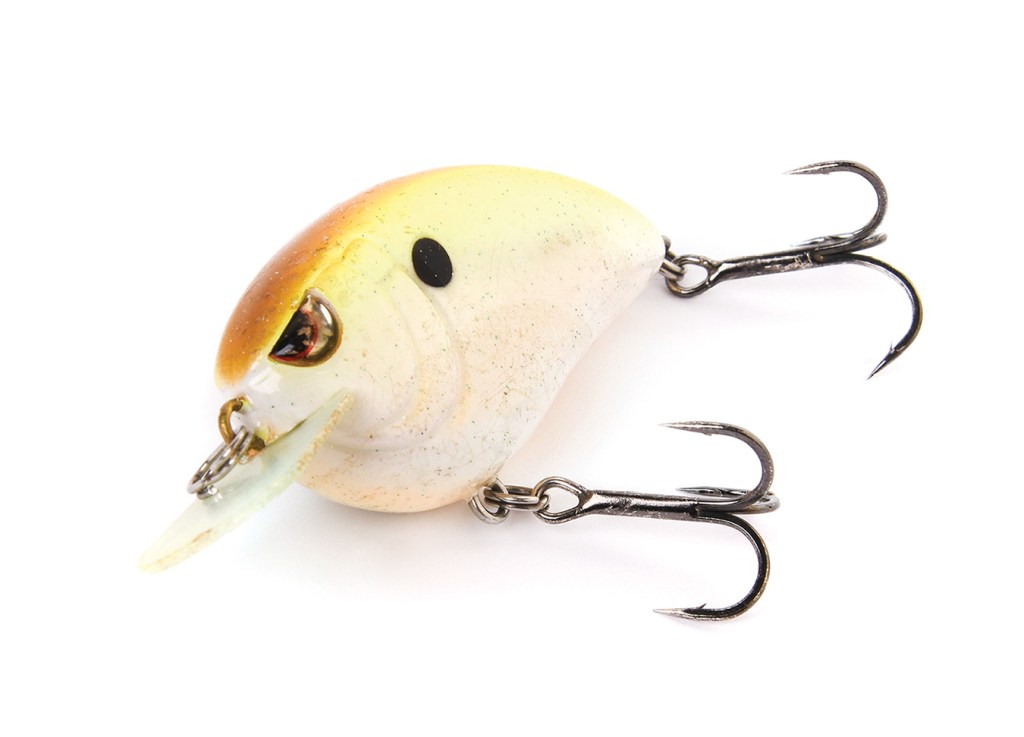
• 7:21 a.m. Frazier’s forward-shooting sonar unit reveals a ball of shad and several larger fish suspended off the bank. He casts a bone Spro McStick jerkbait to the fish and retrieves it with aggressive rod snaps. I ask him how he feels about B.A.S.S.’s recently announced decision to examine the use of forward-facing sonar during Elite Series tournaments with the possible outcome of imposing regulations on the technology. “All I can say is, as long as it’s legal, I don’t want to be caught without it! But like everybody else, I grew up fishing [bottom] structure and shallow cover, so if they decide to restrict it, I’d be perfectly fine with that, too.”
• 7:27 a.m. Frazier exits the cove, idles to Lake L’s dam and casts the plopper to riprap. I inform him that the all-time biggest DOTL bass caught on a topwater lure was Brandon Coulter’s 7-13 largemouth, which hit a plopper on dam riprap. “Really? Then I must be doing something right!”
• 7:30 a.m. He tries the jerkbait around another pod of offshore fish. “I’ll need to catch one to tell if they’re bass, crappie or something else.”
• 7:34 a.m. Frazier casts the Little John to the dam and gets an immediate strike. The fish gets off; Frazier keeps reeling and the bass hooks up again! He swings aboard his first keeper of the day, a 2-pound, 7-ounce largemouth. “This fish was in about 2 inches of water when I first hooked him. Then he followed it off the bank about 10 feet and grabbed it again.”
• 7:40 a.m. He jerkbaits another pod of suspending fish. “So far I’m not seeing any of these offshore fish follow my lure.”
• 7:46 a.m. Back to cranking riprap, Frazier bags a 10-inch bass on the Little John.
• 7:52 a.m. He hangs the squarebill in a piece of waterlogged cloth and uses scissors to free it.
• 7:56 a.m. Frazier moves to a nearby seawall and switches to a bone-colored Spro Aruku Shad lipless crankbait.
• 8:05 a.m. He scopes another pod of suspenders and tries the jerkbait. Still no followers.
SIX HOURS LEFT
• 8:10 a.m. We’re back at the boat ramp, where Frazier is casting the squarebill. “Never pass up casting to a boat ramp! They’re often loaded with minnows and crawfish.”
• 8:16 a.m. He moves farther offshore and unsuccessfully tries the jerkbait around another school of suspenders. “They’re totally not interested.”
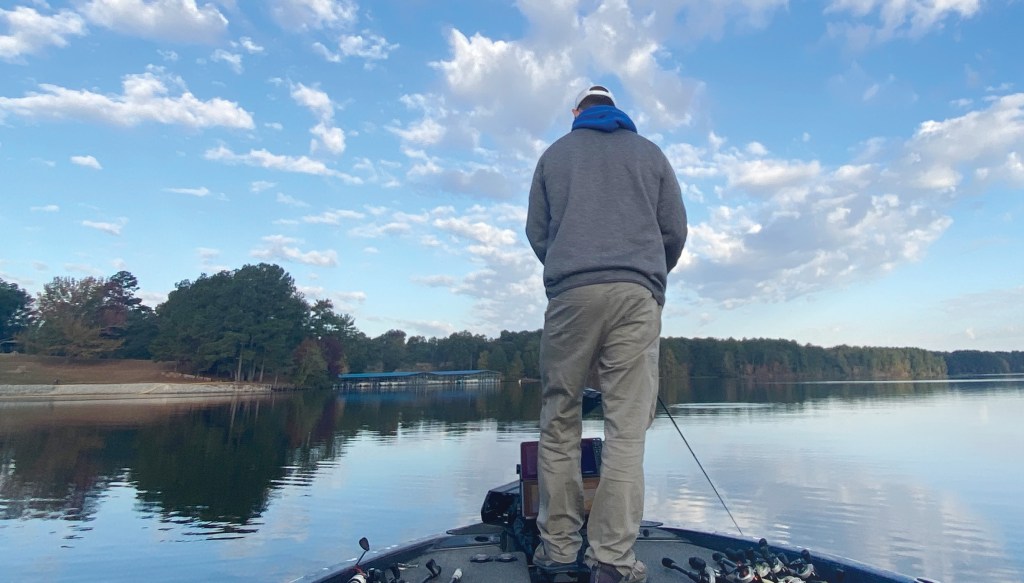
• 8:22 a.m. A bass smacks the plopper at the edge of some emergent grass but doesn’t hook up.
• 8:24 a.m. Frazier slow rolls a white quarter-ounce Nories spinnerbait with tandem Indiana blades through the grass.
• 8:27 a.m. He flips a green pumpkin Nories creature, Texas-rigged with a quarter-ounce sinker and 4/0 offset worm hook, to the grass. “I must have stuck that fish with the plopper [because] he’s not biting anything else.”
• 8:31 a.m. Frazier zips straight across the lake to a creek-channel bank lined with emergent grass and tries the plopper.
• 8:37 a.m. Frazier moves to the opposite bank of the creek and hits a seawall with the squarebill.
• 8:44 a.m. He casts the plopper to the creek’s point but hauls water.
• 8:48 a.m. Frazier scopes a submerged brushpile off the point. He shakes the creature through the shrubbery, gets a tap and sets the hook. Unfortunately, his line tangles around his trolling motor and the bass comes unbuttoned. “Aww, man, that felt like a good one!”
• 8:49 a.m. Frazier casts the squarebill to the brushpile and catches a small yellow bass (panfish).
• 8:53 a.m. He rounds the point and tries the squarebill in a shoreline pocket.
• 9:02 a.m. A light breeze is blowing from the west as Frazier tries the plopper on a main-lake seawall.
FIVE HOURS LEFT
• 9:10 a.m. Frazier’s live sonar reveals a nearby pod of suspenders. He casts the jerkbait to the school; a keeper bass follows it to the boat but doesn’t strike. “Maybe they’re finally waking up.”
• 9:13 a.m. Frazier progresses uplake, cranking the squarebill around moored pontoon boats. A bald eagle sails from a nearby tree to grab a fish off the surface. “At least somebody’s catching something!”
• 9:19 a.m. Frazier continues uplake, casting the spinnerbait to a seawall.
• 9:24 a.m. He bags a short fish off a dock on the squarebill. “The water is getting murkier and warmer the farther uplake I go; it’s 69 degrees here.”
• 9:29 a.m. Frazier races a mile uplake to a main-lake flat with shallow wood and grass. He dredges the squarebill around the cover.
• 9:36 a.m. He enters a shallow pocket, casts the plopper to a patch of emergent grass and catches his second keeper, 1 pound, 6 ounces.
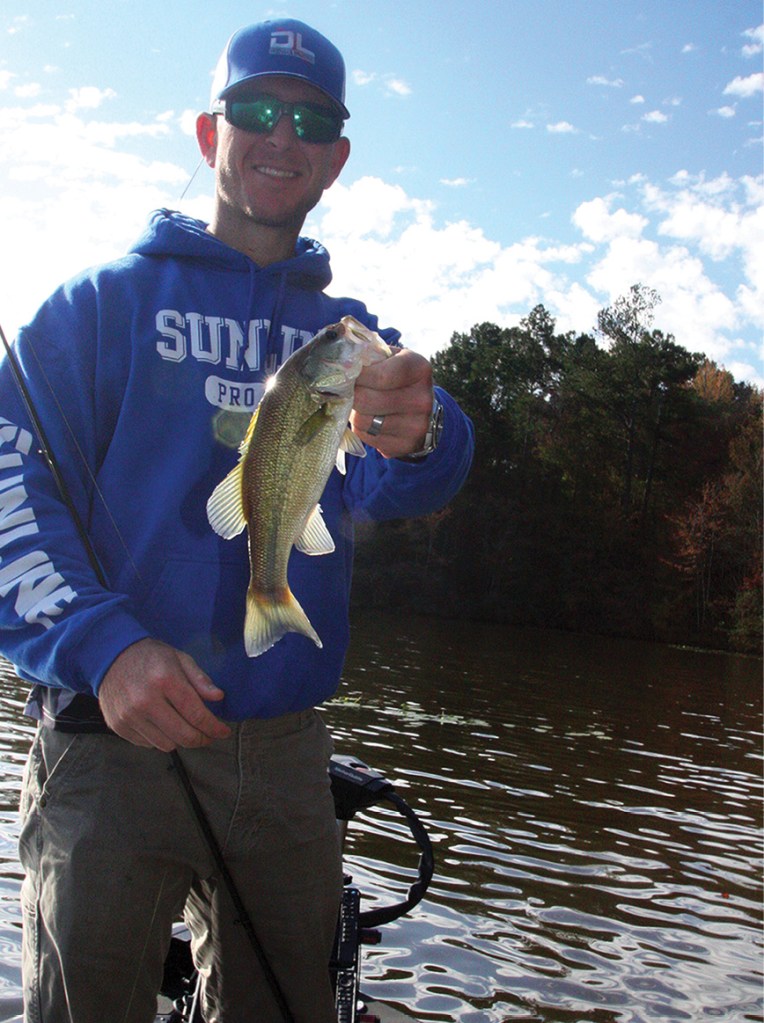
• 9:37 a.m. Frazier casts the plopper back to the grass patch and snares a short bass. “They’re in this grass, but so far they aren’t very big.”
• 9:46 a.m. Frazier has his trolling motor on high while moving downlake with the plopper. He catches another nonkeeper in a grass patch.
• 9:54 a.m. The wind is now blowing 15 mph out of the north as Frazier flips a logjam with the creature.
• 10:02 a.m. Frazier moves uplake to another pocket and retrieves the plopper around lily pads.
FOUR HOURS LEFT
• 10:10 a.m. Another short fish hits the plopper at the edge of the pads. “There’s got to be some bigger fish around these pads and weed patches!”
• 10:16 a.m. Frazier speed trolls to the upper reaches of Lake L, where he casts the plopper to shoreline grass.
• 10:25 a.m. Here, warm, muddy water is entering the lake via a culvert. Frazier locates a 10-foot ditch and catches a 10-inch bass on the jerkbait.
• 10:31 a.m. He bumps the creature through the ditch without success.
• 10:40 a.m. Frazier hangs the creature in submerged brush, breaks off and re-rigs. What’s his take on the day so far? “The fish have been fairly active. I’ve had quite a few bites on topwater, but so far they’ve been small. It’s actually gotten colder since that north wind kicked in; this may be negatively impacting the bigger bass. I’m just going to keep moving around and hopefully get into some better fish.”
• 10:46 a.m. He races back downlake to an island; here the water is 74 degrees. “That’s crazy warm!” He scopes several pods of suspended bass and tries the jerkbait.
• 10:49 a.m. Frazier gets a strike on the jerkbait and swings aboard an 11-inch largemouth. “I’m seeing some bigger ones suspended about 9 feet deep on my electronics.”
• 11:04 a.m. Frazier catches his third keeper, 1-4, off an island point on the jerkbait. “There are fish suspending everywhere around this island!”
• 11:06 a.m. Frazier catches keeper No. 4, 2 pounds even, from the same offshore school. “That fish hit right under my trolling motor. They’re getting bigger, but not by much.”

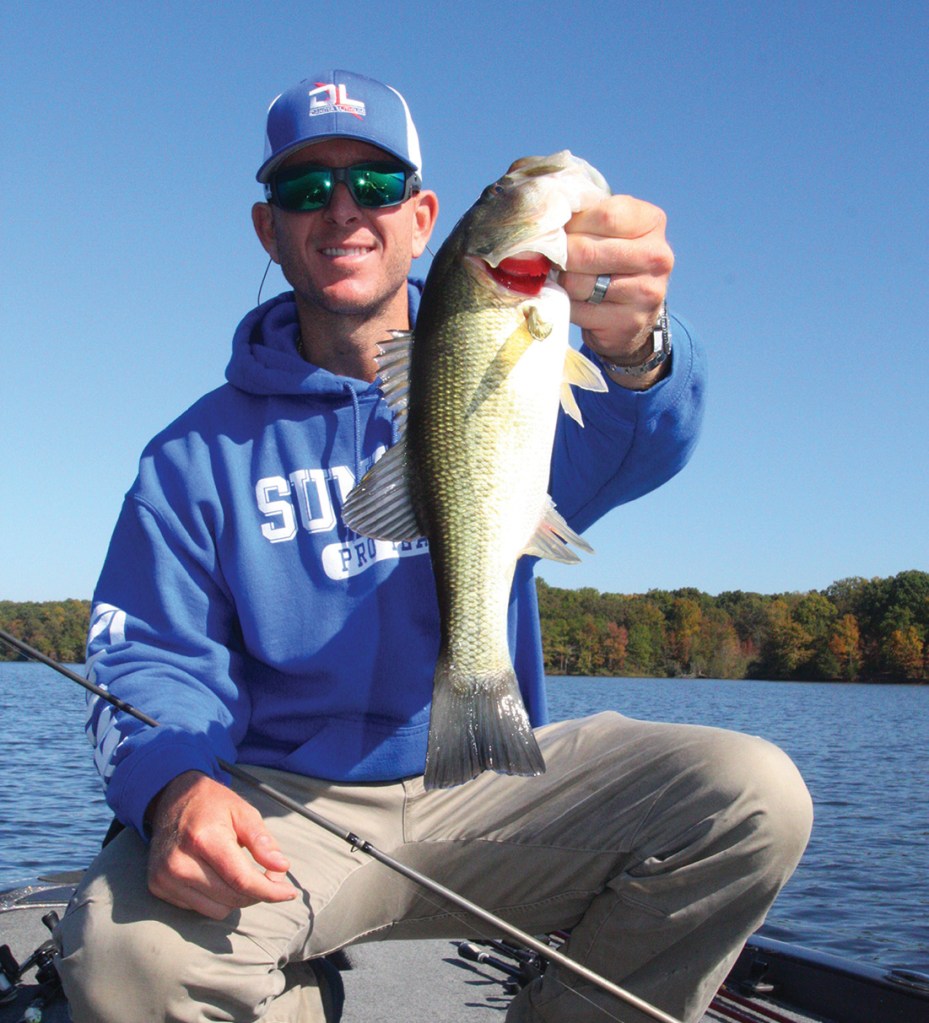
THREE HOURS LEFT
• 11:10 a.m. Frazier is scoping some good fish holding tight to the bottom off the island point, so he opts to try a 5-inch green pumpkin Nories finesse worm on a drop-shot rig.
• 11:16 a.m. Back to the jerkbait. “A jigging spoon would really come in handy here. Unfortunately, I don’t have any in the boat.”
• 11:24 a.m. Frazier catches his fifth keeper, 1-7, off the island on the drop-shot worm. “At least I’ve got my limit! The offshore fish have definitely gotten more active.”
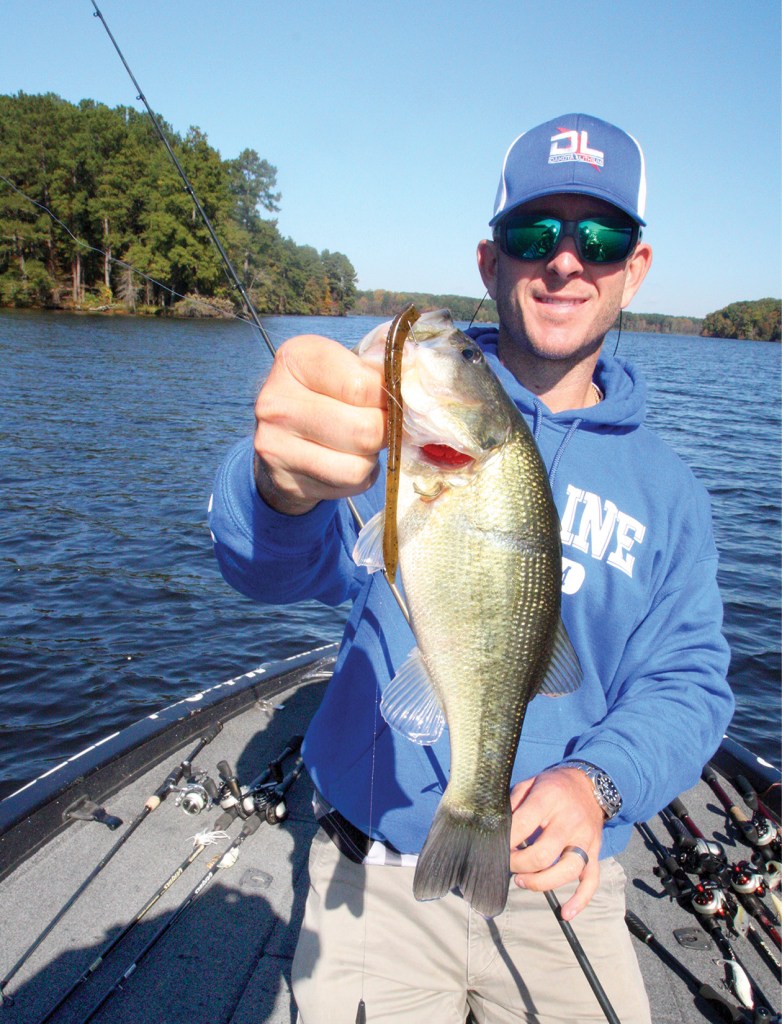
• 11:31 a.m. Frazier is nosing around open water three castlengths off the island, targeting suspended fish. He catches a yellow bass on the jerkbait.
• 11:33 a.m. Another yellow bass hits the jerkbait. “These spiny little buggers are a nuisance!”
• 11:48 a.m. Frazier finally vacates the island and races to Lake L’s eastern shore, where three main-lake points occur close together. Here he tries the jerkbait and drop-shot worm in open water.
• Noon. The north wind is pounding the points as Frazier catches a 10-inch bass on the jerkbait.
TWO HOURS LEFT
• 12:10 p.m. Frazier bags “the world’s tiniest bass” on the jerkbait! “Seriously, what was this dinky fish thinking?”
• 12:17 p.m. Frazier cranks a shallow ledge paralleling a steep channel bank with the squarebill.
• 12:24 p.m. A good fish follows the squarebill to the boat but doesn’t strike it.
• 12:35 p.m. Frazier races back to the island “to see if I can cull those ’pounders.” He quickly locates suspended fish and tries the jerkbait.
• 12:37 p.m. He gets a hard strike on the jerkbait, but the fish shakes free.
• 12:45 p.m. Frazier has caught three more yellow bass on the jerkbait. “I hope they haven’t run the largemouth off!”
• 12:56 p.m. No more action off the island, so Frazier books it downlake to a submerged rockpile. Here he scopes fish suspending off the structure, which is being pounded by 25 mph winds.
• 1:03 p.m. The north wind howls as Frazier nudges the Texas-rigged creature through submerged brush near the rockpile.
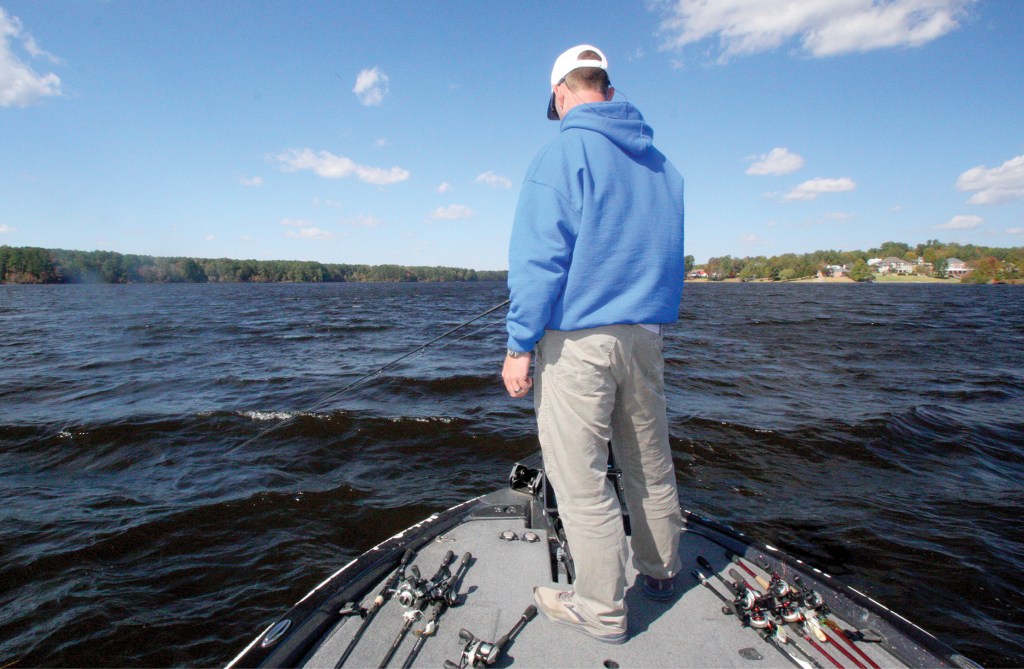
ONE HOUR LEFT
• 1:10 p.m. A bass nips the creature; Frazier swings and misses. “It’s rougher than Lake Ontario out here!”
• 1:24 p.m. Frazier is still nosing around open water near the rockpile with the creature and jerkbait.
• 1:29 p.m. Frazier abandons the rockpile and races back to the cove where he started his day. “There are a bunch of docks in here, so there should be some brushpiles around them. Plus, this cove is out of that cold north wind, so maybe the fish here are more active.”
• 1:33 p.m. Frazier bumps the creature around a dock. “The water is 13 feet deep off the end of this dock. Should be a big one here!”
• 1:40 p.m. Frazier has pinpointed some fish holding near deep brush in the middle of the cove. The Texas-rigged creature can’t coax a bite here, however.
• 1:51 p.m. Frazier switches to the drop-shot worm; it, too, fails to produce. “They’re hanging around that brush, but they just aren’t biting.”
• 1:56 p.m. Frazier moves closer to the cove’s mouth and catches a yellow bass on the jerkbait.
• 2:06 p.m. With minutes remaining, Frazier catches his sixth keeper, 1 pound, 2 ounces, in open water on the jerkbait; it’s no help to his total.
• 2:10 p.m. Time’s up! Frazier has had a fair amount of action on Lake L with not much weight to show for it. His five best fish weigh 8 pounds, 8 ounces.
THE DAY IN PERSPECTIVE
“It was kind of a struggle out here today,” Frazier told Bassmaster. “I had quite a few bites on topwater early, but they were all small fish. I caught most of my keepers offshore around baitfish or brush, but I never could get any big fish to bite. Two factors that may have hurt me are the water being abnormally warm for this time of year, and that strong north wind, which I’m pretty sure gave ’em lockjaw. If I were to fish here tomorrow, I’d spend more time hitting deeper structure and cover in hopes of contacting some bigger fish.”
WHERE AND WHEN FRAZIER CAUGHT HIS FIVE BIGGEST BASS
(1) 2 pounds, 7 ounces; Spro Little John squarebill (root beer chartreuse); dam riprap; 7:34 a.m.
(2) 1 pound, 6 ounces; generic surface plopper (bone); grass in shoreline pocket; 9:36 a.m.
(3) 1 pound, 4 ounces; Spro McStick jerkbait (bone); open water off island point; 11:04 a.m.
(4) 2 pounds; same lure as No.3; same place as No. 3; 11:06 a.m.
(5) 1 pound, 7 ounces, Nories finesse worm (green pumpkin) drop-shot rigged with No. 1 hook; same place as No. 3; 11:24 a.m.
TOTAL: 8 POUNDS, 8 OUNCES
Originally appeared in Bassmaster Magazine 2024.
o

